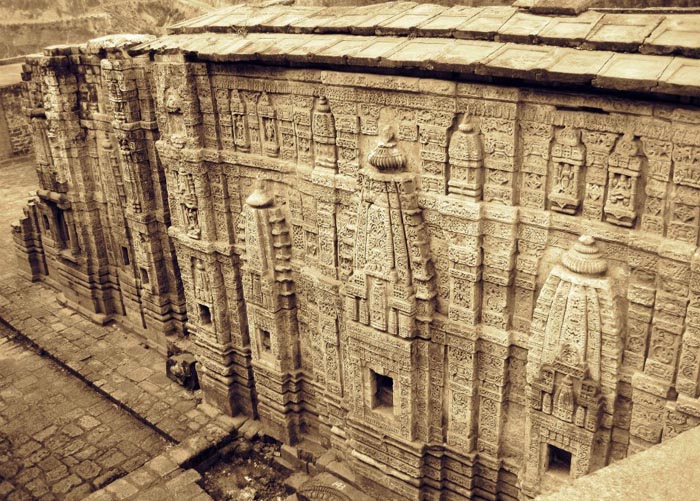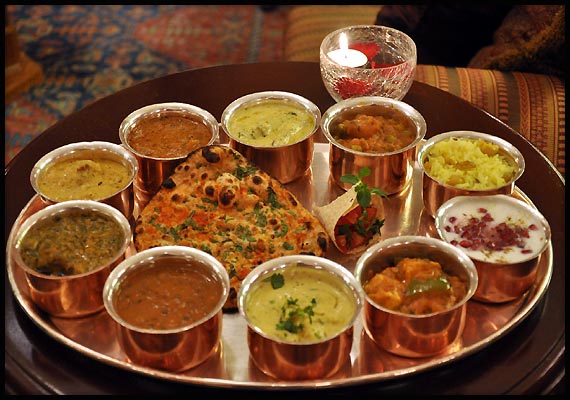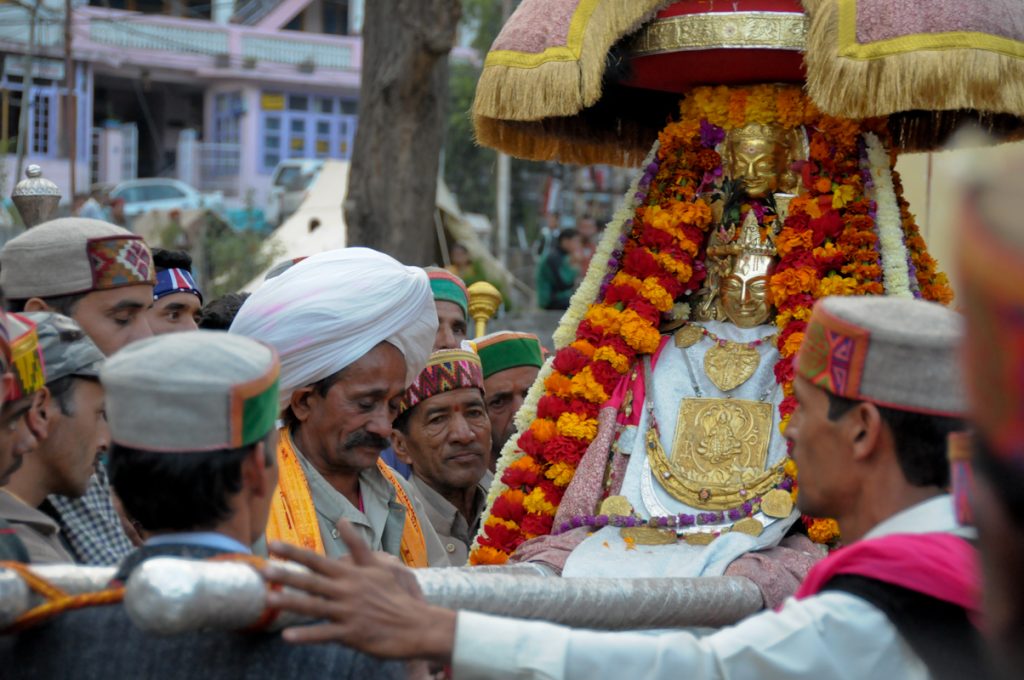Himachal Pradesh – Culture and Tradition

Himachal Pradesh is a hilly state in Northern India. It is one of the most beautiful states of India and known more of as a tourist state, lies in the lap of the King of Mountains, Himalaya, nestling in the lap of nature, it is endowed with lush green forests, bushing streams, emerald meadows, enchanting lakes, and the eternal snows.
The state is bordered by Jammu and Kashmir on the north, Punjab on the west and south-west, Haryana and Uttar Pradesh on the south, Uttarakhand on the south-east and by the Tibet Autonomous Region on the east.
Himachal derives its origin from two Hindi words ‘Him’ and ‘Aanchal’, meaning ‘Snow’ and ‘Lap’ respectively. Thus, etymologically, Himachal Pradesh stands for the region which lies in the slopes and foothills of the Himalayas. Hence Himachal literally means in the lap of snow-covered mountains. It was named by Acharya Diwakar Datt Sharma, one of the great Sanskrit scholars and astrologers of Himachal Pradesh.
Most of the snow-draped peaks, hilltops, banks of lakes and rivers, or natural caves have been considered as sacred as the Adobe of Gods. It is also popularly known as “Dev Bhoomi” or Land of Gods.
Shimla, the capital city of Himachal Pradesh, is the third smoke-free city in India. Shimla has served as the Capital of India during the British Raj, the capital of Punjab, and then the capital of Himachal.
Read more about Himachal Pradesh
History

Himachal Pradesh has been inhabited by human beings since the dawn of civilization. It has a rich and varied history which can be divided into several distinct eras. Himachal Pradesh region was called ‘Deva Bhoomi’. In the early period, tribes like the Koilis, Halis, Dagis, Dhaugris, Dasa, Khasas, Kinnars, and Kirats inhabited it.
The Aryan influence in this area of India dates to the period before the Rigveda. Sankar Varma, the king of Kashmir exercised his influence over regions of Himachal Pradesh in about 883 AD.
This region witnessed the invasion of Mahmud of Ghazni in 1009 AD, who during that period invaded and looted the wealth from the temples in the North of India.
In about 1043 AD the Rajputs ruled over this territory. Known for its vibrant and exquisite natural scenery it received the royal patronage of the Mughal rulers who erected several works of art as an appreciation of this land.
In 1773 AD the Rajputs under Sansar Chand possessed this region, till the attack by Maharaja Ranjit Singh in 1804 which crushed the Rajput power here. The Gurkhas who migrated from Nepal captured this area and devastated it.
In the early 19th century the British exercised their influence and annexed the areas of Shimla after the Gurkha War of 1815-16. The British gradually emerged as the paramount power in the region. During the first Indian war of independence, rulers of hilly states remain inactive. The rulers of Chamba, Bilaspur, Bhagal, and Dhami, rendered help to the British government during the revolt. During World War I, virtually all rulers of the hill states remained loyal and contributed to the British war effort, both in the form of men and materials.
The Chief Commissioner’s province of H.P. came into being on 15th April 1948. This Pradesh became a part C state on 26th January 1950 with the implementation of the Constitution of India. Bilaspur was merged with Himachal Pradesh on 1st July 1954. Himachal Pradesh became Union Territory on 1st November 1956. Kangra and most of the other hill areas of Punjab were merged with Himachal Pradesh on 1st November 1966 though its status remained that of a Union Territory. On 18th December 1970, the State of Himachal Pradesh Act was passed by Parliament and the new state came into being on 25th January 1971.
Thus, Himachal Pradesh emerged as the eighteenth state of the Indian Union. It became a centrally administered territory in 1948 with the integration of 31 hill states and received additional regions added to it in 1966.
Culture

Himachal Pradesh is a multireligious, multicultural as well as a multilingual state like other Indian states. In the south of the Greater Himalayas, the presence of Hinduism is strong. In the middle hills, rustic customs appear in worship or many local ‘gods’ and ‘goddess’. In Trans Himalaya, Buddhism has progressed successfully for more than 1,000 years. The presence of Christianity comes with the coming of the British and there are more than a dozen churches in this area in the state. Similarly, there are many places in the entire state which are sacred by the Sikhs. Islam records its presence in Nahan and some of the major cities around.
Cultural and geographically, there are three well-defined areas of the state. ‘Adivasi belt’ belongs to Kinnaur and Lahaul-Spiti districts, it is largely Buddhist and the language is related to the Himalayan Belt of Tibetan-Burmese. The middle belts embrace this band and are characterized by wild hills and farmland valleys – with slopes, villages, farms, and orchards. Sub-healthy people of Himachal practice farming and this region is traditionally the largest concentration of population. Culture has been fostered by discrete people who live harmoniously on the same land.
Language
The official language of this state is Pahari and Hindi. Some of the most commonly spoken individual languages are Kangri, Mandeali, Kulvi, Chambeali, Bharmauri, and Kinnauri.
Cuisine

There are not many specific varieties that one can get in Himachal Pradesh. A long-time relationship with Punjab and large-scale migration of Tibetans ensured the impact of the Tibetan and Punjabi cuisine on Himachal.
Some of the unique Himachali cuisines include Nasasta (a sweetmeat) in the Kangra region; Indra (made of Urad dal), Baadi / Shaunda, and Bada/Poldu in the Shimla region; apart from favorites all over the state like Pateer, Chuck, Bhagjery and chutneys of Til (sesame seeds).
Popular Vegetarian Dishes include Guchhi Mattar, Sepu Vadi, and Kaddu ka Khatta. While popular Non-Vegetarian Dishes are Kullu Trout, Grilled Fishes, and Chicken Anaardana. The popular sweets are Mittha and Nasasta which are made from Sweet Rice and Sweetmeat. Popular drinks of HP are Tea that is made in varieties of Buttermilk. Himachal Pradesh is the second-largest producer of apples after Jammu and Kashmir.
Suggested Read: Famous Food Of Indian States
Fairs and Festivals

Apart from all festivals celebrated in India there are some unique festivals of Himachal Pradesh. Some of these fairs and festivals in the upper regions are the Kullu Dussehra, Shivratri Fair (Mandi), Shoolini Mela (Solan), Minjar Fair (Chamba), Mani Mahesh Chhari Yatra (Chamba), Renuka fair (Sirmaur), Lavi Trade Fair (Rampur), Vrajeshwari fair (Kangra), Jwalamukhi Fair (Jwalamukhi), Holi Fair (Sujanpur Tira), and Naina Devi Fair (Bilaspur), Fulaich (Kinnaur Valley).
While some popular festival in the lower region is Peeplo Fair, the ‘Mairi’ Guruduwara Fair, the ‘Chintpurni’ temple Fair, the ‘Kamakhya temple’ Fair, including the annual Himachal Hill Festival in the village Polian Purohitan during the fourth week of October.
The Kullu Dussehra festival is very famous all over India. The centuries-old Sair festival is celebrated mainly in Shimla, Mandi, Kullu, and Solan districts every year in mid-September.
Music and Dance

Music and dance reflect the culture and the tradition of Himachal Pradesh. Mostly every district has a unique form of Himachal dance. Those are Losar, Shona, Chuksam (Kinnaur), Dangi (Chamba), Gee, Burah, (Sirmour), Naati, Kharait, Ujagjama and Chadhgebrikar (Kullu) and Shunto (Lahaul & Spiti), Jhamakra (Kangra). Some of the dance forms like Dulshol, Dharveshi, Drodi, Dev Nritya, Rakshas Nritya, Dangi, Lasa, Nati, and Nagas are danced all over the region.
Art and Crafts
Himachal is well known for its handicrafts. The most popular craft works of the people of Himachal Pradesh are Wood Carving, Painting, The Pahari Paintings of Mid-17th Century, Painters from the Mughal Court, Kangra School of Paintings, The Kangra style of Paintings, Thangkas, Rugs & Carpets, Garments & Accessories, Embroidery, Woollen Garments, Shawls, Leathercraft, Jewellery, Metalwork, Another Metalcraft- Mohra, and Stonework. Pashmina shawl is one of the products which is highly in demand not only in Himachal but all over the country.
Traditional Chamba chappals (slippers) are the popular things made out in leather and the embroidery work will be using colors like red, black, green, yellow, blue and imitation zari (gold thread).
Costume

The people of Himachal Pradesh mostly wear woolens as its best suited to the climate. Scarves and shawls are ubiquitous with the women while the men can be found in various types of Kurtas and the typical Himachal cap.
Their outfits are very vibrant and colorful, and almost everything is weaved manually be it a cap, dress, or footwear. Men usually wear tight Churidar Pyjamas with kurta and long silk overcoat over it and a turban. The overcoat is made of yak leather to keep them warm. Women wear long kurtas covering them from neck to their toe. They also wear Ghaghris, Salwar-Kameez, and Cholis i.e. the shirt.
The Himachali cap is a must traditional wear, it is a ‘brand’ known to many. The shawls of Himachal are very famous they are available in Lambs Made of wool, Angora, Pashmina. Among the jewelry they wear are elliptical anklets, solid iron-headed bangles, hair ornaments, peepal-leaf-shaped forehead ornaments, necklaces are known as chandanhaars.
Suggested Read: Traditional Dresses Of Indian States
Transport

Roads are the only lifeline in the State for connectivity as Railways & Inland Water Transport have negligible existence in the State.
Tourism

Himachal Pradesh is the land of lush green fields and a vibrant entrepreneurial culture. It is famous for its Himalayan landscapes and popular hill-stations. These hill stations decorate Himachal Pradesh and make it the most popular tourist spot in India.
The most famous hill stations of Himachal Pradesh are Chail, Dalhousie, Dharamsala, Kasauli, Lahaul, and Spiti. Namgyal Monastery, War Memorial, Viceregal Lodge are the fascinating historical monuments of the state.
There is much exotic wildlife that has been brought up in the zoo and parks of Himachal Pradesh and the most famous zoo of this state is Rewalsar Zoo and Gopalpur Zoo. The most famous parks and sanctuaries of this state are The Great Himalayan National Park, Simbalbara Sanctuary, Chail Sanctuary, Churdhar Sanctuary, Renuka Sanctuary, Daranghati Sanctuary, and Valley National Park. The most famous forts of this state are Kangra Fort, Sujanpur Fort, Kamru Fort, and Nurpur fort.

The most popular tourist spots of Himachal Pradesh are Manali, Shimla, Khajjiar, Chail, Dalhousie, Kullu, Chindi, Kalpa, Dharamshala, Rewalsar, Renukaji, Kasauli, Kiarighat, Bilaspur, Chamba, Fagu, Naldehra, Jawalaji, Palampur, Bhagsu, Sarahan, and Rampur. The most popular Hindu Temples are Bajreshwari Temple, Jwalamukhi Temple, Chamunda Devi Temple, Lakshmi Narayan Temple, Chaurasi Temples, Chattari Temples, and Prashar Temple.
Suggested Read: Formation Dates of Indian States






